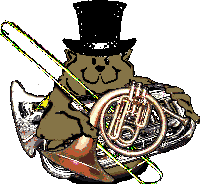Early Brass
Early lip aerophone players (other than trombone players) had a disadvantage over other musicians due to the fact that they could not play all the notes of the scale, as could the string and woodwind players. But, they had the advantage that they could play louder than string and woodwind players, so a family of 'brass' instruments was sought that could produce complete music.
Early attempts were made from animal horns,

And, some were make with long lengths of tubing which allowed the notes to be somewhat closer,
 and by inserting the hand in the bell (which alters the pitch) they were able to get most notes, though they had different tonal qualities.
and by inserting the hand in the bell (which alters the pitch) they were able to get most notes, though they had different tonal qualities.
Early Attempts
The problem was particularly pronounced in the lower octaves, and long pieces of wood in the shape of a conical tube were wrapped with leather and holes were drilled into them to form an instrument, named a "serpent".

This Serpent contains approximate 8 feet of tubing.

Keyed Brass
In the early 19th Century, keys similar to those on woodwind instruments were applied  to a Bb bugle, and was given the name of Kent Bugle.
This is a 9 key model.
to a Bb bugle, and was given the name of Kent Bugle.
This is a 9 key model.
Soon after, the higher pitched Eb keyed bugle was developed and it soon became the melodic voice
 of the keyed instrument family. This is a Wright Eb 10 key Keyed Bugle.
of the keyed instrument family. This is a Wright Eb 10 key Keyed Bugle.
The Ophicleide was the tenor/bass voice
 of the keyed instrument family and soon replaced the more cumbersome serpent.
This instrument was mady by Guichard in Paris Brevette model. Forty-five inches tall with nine keys.
of the keyed instrument family and soon replaced the more cumbersome serpent.
This instrument was mady by Guichard in Paris Brevette model. Forty-five inches tall with nine keys.
Civil War Over the Shoulder Saxhorns
Before the Civil War, an over the shoulder (OTS) instrument was developed to provide music to participants in parades. And, the OTS instrument became the dominant form of saxhorn during the war. And, although they were over produced and glutted the market after the war, the OTS instrument never regained the popularity it had during the war.
This is an example of a Boston Manufactory Cornet.

This alto horn was made in 1861 by Allen & Hall, 334 Washington St. Boston

This is an unmarked Bass OTS saxhorn.

A highly regarded maker during the Civil War was John F. Stratton of New York. The next two are examples of his work
This is an Eb Alto OTS Saxhorn.

This is an Eb Bass OTS Saxhorn.

Civil War Concert Saxhorns
The Concert style configuration for the saxhorns were characterized by instruments where the bells were either pointed forward or upward.
The Eb cornet was the melodic voice in the brass bands of the Civil War, and for some years following that. The next two instruments are examples.

This cornet was made by Lyon & Healy of Chicago.

This is an example of an Eb Alto saxhorn, with Berlinner pumpen valves.




